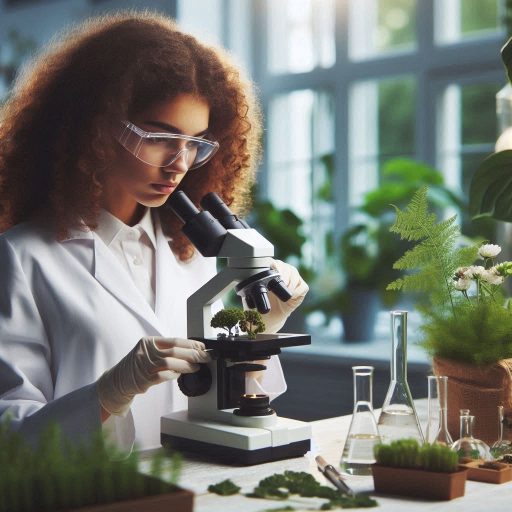Introduction
Botanists play a critical role in environmental conservation by studying plants and their ecosystems.
Their research helps protect biodiversity and maintain ecological balance.
Without botanists, many plant species and habitats would face higher risks of extinction.
The Importance of Botanists in Conservation
Botanists contribute significantly to the preservation of plants and ecosystems by:
- Identifying and classifying plants: They discover new species and document endangered ones.
- Monitoring plant health: Botanists detect threats like invasive species or diseases early.
- Restoring habitats: They rehabilitate degraded environments to support plant regrowth.
- Advising on sustainable practices: Botanists guide industries and communities on reducing environmental impact.
Their efforts ensure that ecosystems remain resilient and provide essential services like clean air, water, and food.
Botanists also play a key role in reforestation projects and climate change research.
By preserving plant life, they help maintain the delicate balance needed for all species to thrive.
In this post, we explore how botanists actively contribute to environmental conservation efforts worldwide.
Understanding their work encourages support for protecting our planet‘s ecosystems.
Overview of Botanists
A botanist is a scientist who studies plants, their structure, growth, and interactions with ecosystems.
Their expertise spans plant anatomy, ecology, genetics, taxonomy, and physiology.
Botanists play a critical role in maintaining biodiversity and promoting environmental conservation.
Areas of Expertise
Botanists focus on different plant-related disciplines to support conservation efforts:
- Plant taxonomy: Classifying and naming plant species to track biodiversity.
- Plant ecology: Studying the relationships between plants and their environments.
- Ethnobotany: Exploring the cultural and medicinal uses of plants by communities.
- Plant physiology: Understanding how plants grow and respond to environmental changes.
- Paleobotany: Investigating ancient plant life and its relevance to modern ecosystems.
Types of Botanists and Their Roles in Conservation
Field Botanists
- Identify plant species in natural habitats.
- Monitor endangered species to prevent extinction.
- Map vegetation patterns for ecosystem management.
Ecological Botanists
- Study plant interactions within ecosystems.
- Develop restoration plans for damaged habitats.
- Guide reforestation projects to combat deforestation.
Conservation Botanists
- Preserve rare and native plant species.
- Collaborate with environmental organizations on protection strategies.
- Maintain botanical gardens as conservation hubs.
Agricultural Botanists
- Research crop improvement to ensure sustainable farming.
- Promote drought-resistant and native crops to conserve water.
- Support eco-friendly agricultural practices.
Phytochemists
- Extract plant-based compounds for pharmaceutical use.
- Identify plant toxins to protect ecosystems and wildlife.
Botanists‘ diverse expertise makes them essential partners in conservation efforts.
By applying scientific knowledge, they help protect ecosystems, restore habitats, and promote sustainable use of plant resources.
Their work ensures that future generations benefit from healthy and diverse natural environments.
Research and Identification of Plant Species
How Botanists Conduct Research to Identify and Classify Plant Species
Botanists play a crucial role in environmental conservation by researching and identifying plant species.
They conduct detailed fieldwork to collect plant samples from diverse ecosystems.
Equipped with tools such as field guides and GPS devices, they meticulously document each species’ location, appearance, and habitat.
Back in the lab, botanists analyze these specimens using microscopy, DNA sequencing, and other advanced techniques to confirm species identification.
The classification process involves comparing collected samples to known species or discovering entirely new ones.
Botanists use taxonomic keys, which are step-by-step guides that help determine a plant’s species, genus, and family.
These keys consider characteristics such as leaf shape, flower structure, and reproductive features.
When a botanist identifies a new species, they document it by creating a detailed description, including its characteristics, habitat, and any potential threats to its survival.
The Significance of Accurate Plant Identification for Conservation Efforts
Accurate plant identification is vital for successful conservation efforts.
It enables scientists and policymakers to understand which species are at risk and require protection.
Many plants play key roles in their ecosystems, providing food and shelter for wildlife, maintaining soil health, and regulating water cycles.
Misidentifying a species can lead to ineffective conservation strategies or even harm to other plants and animals.
For example, protecting the wrong species might allow invasive plants to thrive, displacing native ones and destabilizing the ecosystem.
In addition to identifying individual species, botanists assess the overall health and diversity of plant populations.
They monitor how plant species respond to environmental changes, such as climate shifts, deforestation, or pollution.
By tracking these changes, botanists can provide early warnings about declining species or degraded habitats.
This information helps conservationists develop targeted strategies to protect vulnerable ecosystems.
Botanists also contribute to the preservation of rare and endangered plants.
Through their research, they identify species that are on the brink of extinction and work to create recovery plans.
These plans might involve cultivating plants in botanical gardens, restoring damaged habitats, or reintroducing species to their natural environments.
Overall, botanists‘ research and identification efforts are essential for maintaining biodiversity and preserving ecosystems.
By accurately identifying plant species, they help protect endangered species, restore ecosystems, and ensure the long-term sustainability of our planet‘s natural resources.
Their work serves as the foundation for successful conservation strategies, benefiting not only plants but also the broader environment and human communities that depend on healthy ecosystems.
Read: Earning Potential: Chemist Salaries Across US States
Conservation of Endangered Plant Species
Botanists play a vital role in conserving and protecting endangered plant species.
Transform Your Career Today
Unlock a personalized career strategy that drives real results. Get tailored advice and a roadmap designed just for you.
Start NowTheir expertise ensures that rare plants survive and thrive despite environmental challenges.
Through research, fieldwork, and collaboration, botanists create sustainable solutions to protect these species from extinction.
How Botanists Help Conserve Endangered Species
- Identify and Monitor Threats: Botanists conduct field surveys to track populations and assess threats like habitat loss and invasive species.
- Research Species Requirements: They study endangered plants to understand their ecological needs, including soil type, water availability, and pollinators.
- Collaborate with Conservation Organizations: Botanists work with governments, NGOs, and communities to implement conservation programs.
- Develop Conservation Plans: They create action plans tailored to specific species to ensure their survival in the wild.
- Raise Public Awareness: Botanists educate the public about the importance of preserving endangered plants.
Key Strategies and Methods for Safeguarding Endangered Plants
- Seed Banking: Botanists collect and store seeds to preserve plant diversity for future generations.
- Propagation and Cultivation: They propagate endangered plants in botanical gardens for reintroduction into their natural habitats.
- Habitat Restoration: Botanists restore degraded ecosystems to make them suitable for endangered species.
- In-situ Conservation: This strategy protects plants in their natural environments through monitoring and habitat management.
- Ex-situ Conservation: When habitats are too damaged, botanists relocate plants to controlled environments like greenhouses.
- Biotechnological Methods: Botanists use tissue culture and cloning to produce healthy plants for reintroduction.
- Legal Protections: They advocate for laws to protect endangered species and restrict harmful activities.
Botanists are central to the survival of endangered plants.
Their strategies, combined with scientific expertise, help prevent extinction and ensure biodiversity for future generations.
Read: Top Chemistry Departments and Schools in the US

Restoration of Ecosystems
Botanists play a key role in restoring ecosystems that have been damaged by human activities or natural disasters.
Their expertise in plant species, soil health, and ecological relationships allows them to effectively rehabilitate degraded landscapes.
By reintroducing native plant species and improving soil conditions, botanists can help revive ecosystems and promote biodiversity.
How Botanists Work to Restore and Rehabilitate Degraded Ecosystems
One way botanists work to restore ecosystems is by conducting thorough assessments of the affected areas.
They evaluate soil quality, water availability, and the presence of invasive species that might hinder recovery.
This data helps them design targeted restoration plans that address specific environmental issues.
Botanists also work closely with ecologists, hydrologists, and conservationists to develop multidisciplinary strategies for ecosystem recovery.
Replanting native species is a fundamental step in ecosystem restoration.
Botanists identify plant species that are best suited to the local environment and work to propagate them.
These plants not only restore the landscape but also support wildlife that depends on them for food and shelter.
By bringing back native species, botanists help stabilize ecosystems and prevent further degradation.
In addition to replanting, botanists often rehabilitate soil health to ensure long-term ecosystem success.
They may introduce organic matter, such as compost, to improve soil fertility.
In some cases, they use techniques like mycorrhizal inoculation, which enhances plant-root interactions and promotes nutrient absorption.
These efforts result in healthier plant growth and a more resilient ecosystem.
Examples of Successful Ecosystem Restoration Projects Led by Botanists
One successful example of ecosystem restoration led by botanists is the restoration of the Loess Plateau in China.
Decades of deforestation and overgrazing had turned the region into a barren desert.
Botanists worked with local communities to replant native grasses and trees, which stabilized the soil and reduced erosion.
Over time, the Loess Plateau has been transformed into a thriving green landscape, supporting agriculture and wildlife once again.
Another notable project is the restoration of the Florida Everglades.
This fragile wetland had suffered from water diversion and habitat destruction.
Botanists led efforts to reintroduce native wetland plants, such as sawgrass and cypress trees.
By restoring natural water flows and planting these key species, botanists have helped revitalize the Everglades, making it one of the most successful ecosystem restoration projects in the world.
Through careful planning, native species reintroduction, and soil rehabilitation, botanists can revive ecosystems and ensure their long-term survival.
Their work is vital for reversing environmental damage and protecting biodiversity.
As more ecosystems face degradation, botanists will continue to play a critical role in their restoration and recovery.
Read: How to Become a Licensed Chemist in the USA: Steps and Tips
Collaboration with Other Conservation Professionals
Botanists play a critical role in environmental conservation.
However, achieving meaningful conservation goals requires collaboration with other professionals.
This joint effort maximizes expertise and resources, leading to more effective strategies.
The Importance of Collaboration
- Combining Expertise: Botanists contribute specialized knowledge about plant species and ecosystems, complementing other experts’ insights.
- Broadening Impact: Collaborative efforts ensure conservation plans address multiple ecological aspects, like wildlife preservation and climate adaptation.
- Strengthening Advocacy: When botanists and other professionals work together, their recommendations carry more weight in policy discussions.
How Botanists Collaborate
1. With Scientists
- Botanists team up with ecologists and zoologists to study how ecosystems function.
- They share data with climate scientists to assess environmental changes and plan mitigation efforts.
2. With Policymakers
- Botanists provide critical data on endangered species for environmental legislation.
- They assist in developing policies that protect native plants and promote reforestation.
3. With Community Members
- Botanists engage local residents in conservation through educational workshops.
- They work with indigenous communities to preserve traditional ecological knowledge and restore habitats.
Collaboration creates well-rounded conservation strategies that consider diverse perspectives and expertise.
It ensures conservation initiatives are grounded in science while addressing social and economic factors.
This synergy empowers environmental teams to tackle complex challenges and build sustainable solutions.
Read: Biology Ethics: Navigating Complex Issues in the US
Learn More: Best Universities for Studying Pharmacology in the USA
Discover More: Nanotechnologist Work Environment and Conditions
Public Education and Outreach
Botanists play a crucial role in environmental conservation through public education and outreach.
They engage communities by sharing knowledge about plant species and ecosystems.
Their expertise helps people understand the intricate relationships within nature.
By highlighting the importance of plants, botanists inspire individuals to protect their environment.
The Role of Botanists in Educating the Public About Plant Species and the Importance of Environmental Conservation
Public education initiatives often take various forms.
Workshops, seminars, and school programs allow botanists to reach diverse audiences.
They design these programs to cater to different age groups and backgrounds.
Through hands-on activities, participants connect with plants on a personal level.
This interactive approach fosters a deeper appreciation for local flora.
Botanists also utilize social media and online platforms to extend their outreach.
They share informative content, such as articles and videos, about plant conservation.
This digital presence allows them to reach a global audience quickly.
Engaging visuals and relatable language help capture attention and spread awareness.
Collaboration with local organizations amplifies their impact.
Botanists partner with schools, museums, and conservation groups to develop educational materials.
These partnerships create comprehensive programs that resonate with community members.
Joint efforts often lead to community events focused on environmental conservation.
Transform Your Career Today
Unlock a personalized career strategy that drives real results. Get tailored advice and a roadmap designed just for you.
Start NowThe Impact of Public Outreach Efforts in Raising Awareness and Promoting Conservation Practices
One significant outcome of public outreach is increased awareness of native plant species.
People often overlook these plants in favor of exotic species.
Botanists educate communities about the benefits of using native plants.
Native species support local wildlife and promote biodiversity.
This knowledge encourages residents to choose native plants for landscaping and gardening.
Moreover, public outreach fosters a sense of responsibility towards the environment.
When people understand the role plants play in ecosystems, they become more motivated to protect them.
Educational programs can inspire community members to participate in local conservation efforts.
Many communities organize volunteer days for planting trees or restoring habitats.
The impact of these initiatives can be profound.
Increased public awareness leads to improved conservation practices.
Communities that understand the importance of native plants often advocate for sustainable practices.
These practices include reducing pesticide use and supporting local nurseries that grow native plants.
Essentially, botanists significantly contribute to environmental conservation through education and outreach.
Their efforts promote awareness and understanding of plant species.
By engaging communities, botanists empower individuals to take action.
Ultimately, this collective knowledge fosters a culture of conservation that benefits our planet.
Through public education, botanists ensure that future generations appreciate and protect our precious natural resources.
Conclusion
Botanists play a crucial role in environmental conservation.
Their work focuses on understanding plant species and their habitats.
Through research and fieldwork, they identify plants that are endangered or threatened.
This knowledge is vital for developing effective conservation strategies.
Botanists also help assess the health of ecosystems by studying plant communities.
By examining plant interactions within ecosystems, botanists provide insights into biodiversity.
They monitor the effects of climate change on plant species.
This information is essential for predicting future environmental changes.
Botanists collaborate with conservation organizations to protect endangered species and their habitats.
Their expertise helps create conservation plans that prioritize plant diversity.
In addition to research, botanists engage in public education.
They raise awareness about the importance of plant conservation.
By educating communities, they foster appreciation for local flora.
This connection encourages individuals to participate in conservation efforts.
Botanists often lead workshops and outreach programs to promote sustainable practices.
Their efforts inspire others to value and protect the natural environment.
Botanists also contribute to habitat restoration projects.
They work to restore ecosystems that have been degraded or damaged.
This work often involves reintroducing native plant species to promote biodiversity.
By restoring plant communities, they help revive ecosystems and support wildlife.




